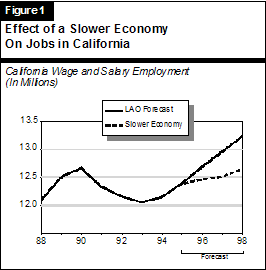

A variety of factors could result in the General Fund's condition
turning out to be considerably different than our projections summarized in Chapter 1. These factors include: a differently performing economy than we have forecast, major federal budgetary changes (such as federal health and welfare reform), adverse litigation outcomes, natural disasters, and unexpected developments in major caseloads. This chapter discusses some of these factors.A SLOWER ECONOMY
The single largest risk to our budget outlook is a weaker-than-forecast
economy. As discussed in Chapter 2, our forecast assumes moderate economic growth and low inflation during the next three years. This is generally consistent with the consensus view of other forecasters. There is, however, a significant probability that a serious economic slowdown or recession could occur sometime during the 1996 through 1998 period. The larger forecasting services, for example, place the odds of a slowdown or recession during the next three years at as high as one-in-three.To give an idea of what a soft economy could mean for the fiscal
outlook, we developed an alternative economic forecast which includes weakness in personal income, employment, retail spending, and housing activity. The impact of our slow-growth alternative on California jobs is shown in Figure 1.
To give an idea of what a soft economy could mean for the fiscal outlook, we developed an alternative economic forecast which includes weakness in personal income, employment, retail spending, and housing activity. The impact of our slow-growth alternative on California jobs is shown in Figure 1.
This alternative would reduce General Fund revenues by close to $5 billion over the 1995-96 through 1997-98 period. A full-blown recession would reduce revenues by considerably more. A weaker economy also would raise state spending in health, welfare, and other program areas affected by weak economic conditions, due to higher caseloads. At the same time, it would dampen Proposition 98 spending which is directly tied to the performance of the state's economy.
FEDERAL HEALTH AND WELFARE REFORM
As discussed in Chapter 4, pending health and welfare reform legislation in Congress would, if enacted, have significant fiscal impacts on California.
Regarding welfare reform, we estimate that the state could incur General Fund costs of about $1.5 billion annually in 1996-97 and 1997-98 if it chooses to backfill for the loss of federal funds in order to maintain the level of services to recipients; or, alternatively, the state could realize General Fund savings of about $1 billion annually by conforming its policies to the new federal restrictions on program eligibility (on noncitizens, for example). We note, however, that much of these potential state savings, in the absence of other state law changes, would be offset by costs to the counties, primarily for General Assistance.
While the fiscal impact of federal Medicaid reform proposals is not clear at this time, it appears that California could lose as much as $2 billion annually in federal funds in 1996-97 and 1997-98. Thus, the state could incur substantial General Fund costs if it chooses to backfill for these losses, or achieve General Fund savings by limiting eligibility and/or benefits. Again, much of any savings at the state level would be largely offset by local costs for indigent health care services.
In addition to federal health and welfare reform, other federal budget actions could have significant fiscal implications for the state.
PENDING LITIGATION
There is a variety of pending litigation in which the state is involved. The state faces a significant budget risk due to an adverse trial court decision in the PERS v. Wilson case. If this decision is upheld on appeal, the state would have to pay contributions to the Public Employees' Retirement System (PERS) that have been deferred under previous budget-related actions. If the state loses its appeal, the General Fund exposure is in the range of $1 billion.
OTHER FACTORS
As discussed in Chapter 4, there are a variety of other factors which could significantly affect our spending projections, such as caseload, enrollment trends, and local property tax growth, that differ from those we have projected. The state also faces a risk of about $150 million from a federal audit exception involving the past allocation of employee retirement contribution savings. In addition, the accuracy of our projections will depend on the success of the state in achieving, on an ongoing basis, many of the savings which have been assumed in the current-year's budget.
Given these uncertainties, it is critical that the state establish a meaningful reserve as an insurance policy against these downside risks.